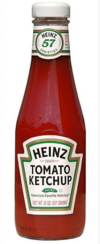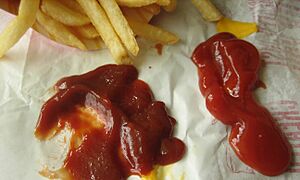Heinz Tomato Ketchup facts for kids
 |
|
 |
|
| Type | Ketchup |
|---|---|
| Owner | Kraft Heinz |
| Country | United States |
| Introduced | 1876 |
| Markets | Worldwide |
| Previous owners | Heinz |
| Tagline | It has to be Heinz |
Heinz Tomato Ketchup is a very popular brand of ketchup. It is made by Heinz, which is part of a bigger company called Kraft Heinz. People all over the world love to put Heinz ketchup on their food!
Contents
The Story of Heinz Ketchup
Heinz first started selling their ketchup in 1876. Back then, it was called "catsup." By 1907, they were making a huge amount of it – 12 million bottles! They even sent it to many countries like Australia, Japan, and the UK.
In 2009, Heinz changed the picture on their ketchup bottle label. Before that, it had a picture of a gherkin pickle. But they changed it to a picture of a fresh tomato. This made sense because ketchup is made from tomatoes! In 2012, over 650 million bottles of Heinz ketchup were sold around the world. That's a lot of ketchup!
How Heinz Ketchup is Made
Heinz makes all its tomato ketchup for the USA market in two factories. These factories are in Fremont, Ohio, and Muscatine, Iowa. They used to have a factory in Canada, but it closed in 2014. Now, that Canadian factory makes ketchup for another brand.
Around the world, Heinz has factories in many different countries. These include the UK and the Netherlands. Even though there is one main recipe for Heinz ketchup, there are small changes. These changes depend on the rules of each country where it is made.
Different Ketchup Kinds
Besides their regular tomato ketchup, Heinz has made other kinds too. They once made a special ketchup with sugar instead of corn syrup.
In the year 2000, Heinz made colorful ketchups for kids. These came in squeezable bottles. You could find them in red, green, purple, pink, orange, teal, and blue! But these fun colors were stopped in 2006.
In 2011, they also started making a ketchup with balsamic vinegar. This special kind was stopped in 2018.
On June 5, 2019, which is National Ketchup Day, Heinz teamed up with singer Ed Sheeran. They released a special, limited-edition ketchup. It was officially called "Ed Sheeran × Heinz ketchup," but many people called it "Edchup."
Saucy Sauce Mixes
Heinz has also created some interesting mixed sauces. These sauces combine two different condiments.
In 2018, Heinz introduced "Mayochup." This name is a mix of mayonnaise and ketchup. Heinz asked people on Twitter if they wanted this sauce in stores. Over 500,000 people voted "yes"! Some people pointed out that similar mixes already existed, like "fry sauce." Mayochup arrived in US stores in September 2018.
After Mayochup was a hit, Heinz made two more mixed sauces in March 2019. These were to celebrate the company's 150th birthday. They released "Mayomust," which is mayonnaise plus mustard. They also made "Mayocue," which is mayonnaise plus barbecue sauce.
In April 2019, they released "Kranch." This sauce mixes ketchup and ranch dressing. Some people thought it was a strange idea, but others were excited to try it!
In January 2020, Heinz announced "Honeyracha," mixing honey and sriracha. Then in February, they announced "Mayoracha," which combines mayonnaise and sriracha.
In March 2021, more mixes came out. These included "Tarchup" (tartar sauce + ketchup), "Wasabioli" (wasabi + aioli), and "Hanch" (hot sauce + ranch dressing). Later that month, two more sauces were announced: "Buffaranch" (Buffalo sauce + ranch dressing) and "Sweet Ketchili" (ketchup + sweet chili sauce).
In June 2024, Heinz released a very special sauce called "Every Sauce." It combined 14 different sauces into one! Only 100 of these were made, making them a rare collector's item.
Ketchup Bottles and Packs
Heinz ketchup comes in many different types of containers. You can find it in glass bottles and plastic squeeze bottles.
The famous octagonal (eight-sided) glass bottle was first used in 1889. It was patented in 1890. This bottle design is still used today and is a well-known symbol of Heinz ketchup.
In restaurants, the common glass bottle holds about 14 ounces (397 grams) of ketchup. In 2002, Heinz introduced an upside-down, squeezable plastic bottle for restaurants. This bottle makes it much easier to get the ketchup out. It also helps use up more of the ketchup inside, so less is wasted. You can find similar squeeze bottles in grocery stores for home use.
Heinz ketchup also comes in small, single-serving packets. These are often made of foil or plastic. In 2010, Heinz created the Dip & Squeeze packet. This clever packet lets you either dip your food into the ketchup or squeeze it out. For hotels, there are small bottles (about 2.25 ounces or 64 grams) that are nicer than the small packets you get at fast-food restaurants.
For places that use a lot of ketchup, like food service companies, it comes in very large containers. These can be metal cans, plastic containers, or even large bags. These big containers often have pumps or fit into dispensers for people to use themselves. The largest size for restaurants is a bag holding 3 US gallons (11 liters). Even bigger containers, holding 260 US gallons (984 liters), are sold to food manufacturers.
A Ketchup Mix-Up
In 2012, there was a situation where some regular Heinz ketchup was put into bottles that had fake labels for "Simply Heinz." "Simply Heinz" uses sugar, while regular Heinz ketchup uses high-fructose corn syrup. This mix-up was found when the place where it was happening was left empty. The ketchup in the bottles started to bubble and the bottles burst open. Heinz worked with the US Food and Drug Administration to look into what happened.
See also


